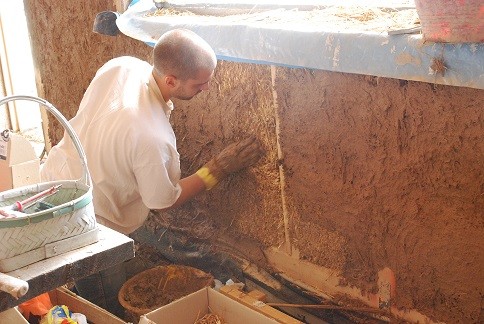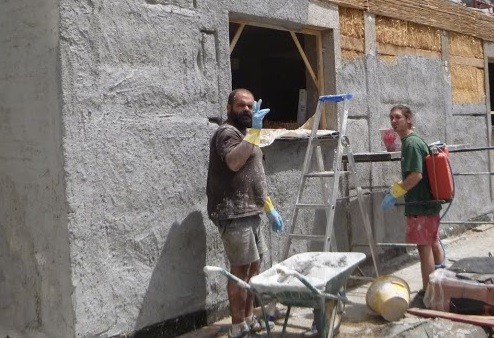
straw bale house italy | straw house italy | Materials and Benefits
Straw and wood
They are renewable materials and during their production cycle does not produce CO2, but rather, contribute to oxygenate our skies.
 They are very healthy materials, anti-allergic, breathable and live.
They are very healthy materials, anti-allergic, breathable and live.
The straw is a natural material, bio-ecological and renewable every year, being the by-product of what we -especially we Italians- eat everyday (wheat) and that in its lifetime absorbs CO2 and release O2. It is often found on site, Km0, although this in Liguria (especially in our area) is very difficoult...for this reason we we made to ship a load of bales from nearby Tuscany.
The bale of straw:
-conversely to what one might believe, is a low fire risk material, in fact has been seen that resists three hours in a flame of 1000 degrees centigrade;
-is an excellent insulating material, having a transmittance U of 0.08, when the cork has 0.04, the brick with mortar 0,18 and the reinforced concrete 2,3!!
-is a soundproofing material so much so that is also used in acoustic halls, airports etc;
-is breathable for indoor humidity and does not cause allergies such as hay;
-is not parasitized.
The Raw Land (clay)
Totally natural element being really earth. 
This has numerous properties:
-regularizes humidity, absorbing or releasing, keeping it at around 50-70%, with significant health benefits for the absence of mold;
-has a good thermal inertia so keeps the temperature around it fairly constant;
-is a soundproofing material for low frequency sounds;
-being colloid, it retains dust, gases and odors;
-protects from electromagnetic fields: according to a study of Monaco, 2.5 cm of plaster eliminate 75% of the radiation from high-voltage system while a clay brick eliminates 98%;
-preserves the beams keeping away humidity so less worms and parasites of the wood;
-ionizes the surroundings bringing numerous benefits to health
The Natural Slaked Lime
 The slaked lime is the healthiest and breathable material which may be of a house. As a third skin, allows the steam, which naturally forms on the inside of our homes, to flow out as a healthy and fresh breath, without on the other hand, allow the water to enter.
The slaked lime is the healthiest and breathable material which may be of a house. As a third skin, allows the steam, which naturally forms on the inside of our homes, to flow out as a healthy and fresh breath, without on the other hand, allow the water to enter.
The Romans used it as a bonding agent for masonry mortars Colosseum and aqueducts are an example of how this formidable hard material over time.
This building material is produced from limestone rock, which is then baked at 950 degrees centigrade and, in addition to carbon dioxide, becomes quicklime; with addition of water is called slaked lime and this is the product that is delivered in bags. With the addition of sand and the slow carbonation on the wall of the house (in contact with the air continues to absorb CO2), the material will tend to return limestone, increasingly hard to hand it passes the time. Unlike cement (who once worked begins its deterioration) also wicks the wall, creating an excellent bond with straw and clay.


